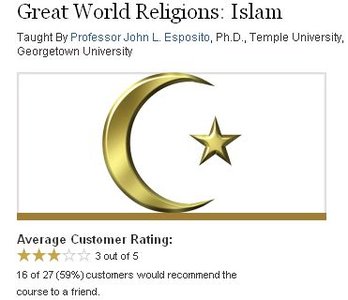
Great World Religions: Islam – John L. Esposito (The Great Courses)
1 Islam Yesterday, Today, and Tomorrow
The diversity of cultural and religious practices of Islam is reflected by the geographic expanse of the Muslim world. Islam’s more than 1 billion followers live in 56 countries around the world, yet many in the West know little about it and are familiar only with the actions of a minority of radical extremists. This lecture outlines the second-largest and fastest-growing of the world’s religions, which is part of the religious landscape of America and Europe, and has had a significant impact on world affairs.
2 The Five Pillars of Islam
All Muslims accept and follow the Five Pillars of Islam, the core beliefs that unite all Muslims across time and space and are the hallmarks that distinguish Islam from other faiths. This lecture describes them.
3 Muhammad—Prophet and Statesman
Muhammad’s significance is the result of his dual roles as God’s messenger and as the perfect living model of the Quran’s teachings. After 10 years of persecution and resistance in Mecca, Muhammad and the early Muslims moved to Medina, where Muhammad served as prophet, political ruler, military commander, chief judge, and lawgiver.
Amazon #ads
4 God’s Word—the Quranic Worldview
Muslims believe that the Quran represents both the original and final revelation of God to humankind, making Islam the oldest, rather than the newest, of the monotheistic faiths. The Quran reveals the compassion and justice of God, the role and responsibilities of human beings, and relations between men and women.
5 The Muslim Community—Faith and Politics
The development of Islam and Muslim history enables us to appreciate the remarkable political and cultural achievements of the Golden Age of Islamic civilization and to understand the sources of sectarianism, religious extremism, and conflict between Islam and Christianity, epitomized by the Crusades.
6 Paths to God—Islamic Law and Mysticism
Piety and the desire for reform resulted in the development of Islamic law (the Shariah) and Islamic mysticism (Sufism). Islamic law reflects Islam’s emphasis on orthopraxy (correct practice), rather than orthodoxy (correct belief). Sufism emphasizes personal spirituality and devotion and has aided the spread of Islam through missionary activities.
7 Islamic Revivalism—Renewal and Reform
From the 17th to the 20th centuries, the Muslim world experienced both internal disintegration and upheaval and the external aggression of the European colonial era. Muslim responses to these challenges varied from jihad against European colonialism to acceptance and blind adoption of the West. Islamic modernists called for a synthesis of Islam and Western thought in order to achieve legal, educational, and social reforms.
8 The Contemporary Resurgence of Islam
In the last decades of the 20th century, a series of political events and economic realities led to the desire of many Muslims to achieve greater authenticity and self-definition through a revival of Islam. Reformist movements have worked within mainstream society for change, but extremists have resorted to violence and terrorism to achieve their goals.
9 Islam at the Crossroads
Like members of other faith communities, contemporary Muslims face the challenge of defining the role, meaning, and relevance of Islam. At the heart of the “struggle for the soul of Islam” between conservatives and reformers, mainstream Muslims and extremists, is the question of who should interpret Islam and how reform should be achieved. Major issues include the relationship of religion to state and society, the role of Islamic law, the status of women and non-Muslims, the compatibility of Islam and democracy, and relations with the West.
10 Women and Change in Islam
The status of women in Islam is a hotly contested issue, both in the Muslim world and in the West. Muslim women are often viewed through Western stereotypes or the policies of extremists, such as the Taliban. Although some critics claim that Islam oppresses women, others view Islam as a source of women’s empowerment. Even the wearing of the veil has diverse meanings for wearers and observers.
11 Islam in the West
Islam is now the third largest religion in the United States and the second largest in Europe. Muslims in Europe and America represent a cross-section of national, ethnic, and racial backgrounds and socioeconomic classes. They, like religious minorities before them, face issues of faith and identity, integration and assimilation.
Amazon #ads
12 The Future of Islam
At the close of the 20th century, it appeared that the future of Islam could be one of new opportunities for peace, democracy, expanded human and women’s rights; political, social, and economic empowerment; and an increasing acceptance in Western societies of the Judeo-Christian-Islamic tradition. The September 11, 2001, hijacking of Islam by militant extremists shattered the hopes and dreams of many Muslims throughout the world. Thus, for Muslims, the 21st century requires educating, engaging in dialogue with, and finding new ways in which to work with and within the West and global civilization.






